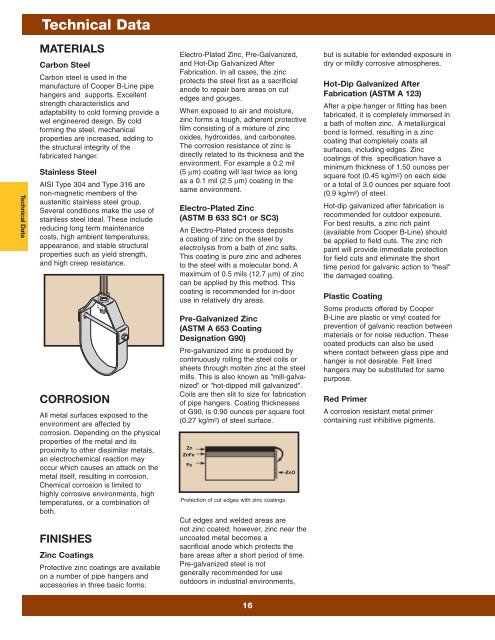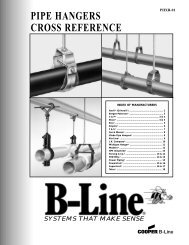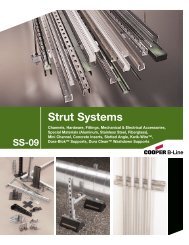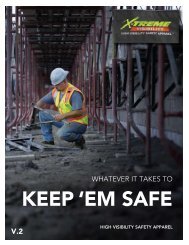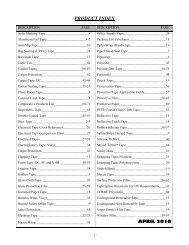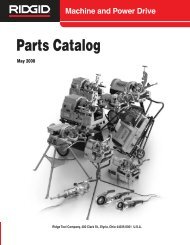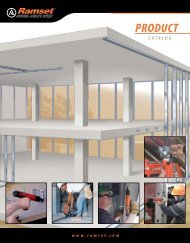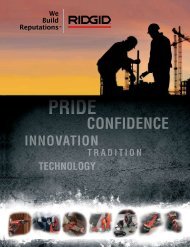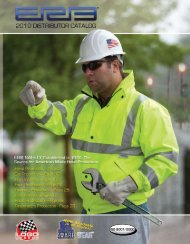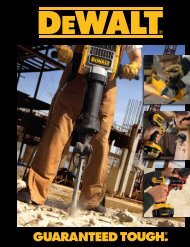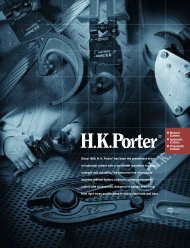Cooper B-Line Pipe Hangers & Supports - Dixie Construction Products
Cooper B-Line Pipe Hangers & Supports - Dixie Construction Products
Cooper B-Line Pipe Hangers & Supports - Dixie Construction Products
Create successful ePaper yourself
Turn your PDF publications into a flip-book with our unique Google optimized e-Paper software.
Technical Data<br />
Technical Data<br />
MATERIALS<br />
Carbon Steel<br />
Carbon steel is used in the<br />
manufacture of <strong>Cooper</strong> B-<strong>Line</strong> pipe<br />
hangers and supports. Excellent<br />
strength characteristics and<br />
adaptability to cold forming provide a<br />
wel engineered design. By cold<br />
forming the steel, mechanical<br />
properties are increased, adding to<br />
the structural integrity of the<br />
fabricated hanger.<br />
Stainless Steel<br />
AISI Type 304 and Type 316 are<br />
non-magnetic members of the<br />
austenitic stainless steel group.<br />
Several conditions make the use of<br />
stainless steel ideal. These include<br />
reducing long term maintenance<br />
costs, high ambient temperatures,<br />
appearance, and stable structural<br />
properties such as yield strength,<br />
and high creep resistance.<br />
CORROSION<br />
All metal surfaces exposed to the<br />
environment are affected by<br />
corrosion. Depending on the physical<br />
properties of the metal and its<br />
proximity to other dissimilar metals,<br />
an electrochemical reaction may<br />
occur which causes an attack on the<br />
metal itself, resulting in corrosion.<br />
Chemical corrosion is limited to<br />
highly corrosive environments, high<br />
temperatures, or a combination of<br />
both.<br />
FINISHES<br />
Zinc Coatings<br />
Protective zinc coatings are available<br />
on a number of pipe hangers and<br />
accessories in three basic forms:<br />
Electro-Plated Zinc, Pre-Galvanized,<br />
and Hot-Dip Galvanized After<br />
Fabrication. In all cases, the zinc<br />
protects the steel first as a sacrificial<br />
anode to repair bare areas on cut<br />
edges and gouges.<br />
When exposed to air and moisture,<br />
zinc forms a tough, adherent protective<br />
film consisting of a mixture of zinc<br />
oxides, hydroxides, and carbonates.<br />
The corrosion resistance of zinc is<br />
directly related to its thickness and the<br />
environment. For example a 0.2 mil<br />
(5 µm) coating will last twice as long<br />
as a 0.1 mil (2.5 µm) coating in the<br />
same environment.<br />
Electro-Plated Zinc<br />
(ASTM B 633 SC1 or SC3)<br />
An Electro-Plated process deposits<br />
a coating of zinc on the steel by<br />
electrolysis from a bath of zinc salts.<br />
This coating is pure zinc and adheres<br />
to the steel with a molecular bond. A<br />
maximum of 0.5 mils (12.7 µm) of zinc<br />
can be applied by this method. This<br />
coating is recommended for in-door<br />
use in relatively dry areas.<br />
Pre-Galvanized Zinc<br />
(ASTM A 653 Coating<br />
Designation G90)<br />
Pre-galvanized zinc is produced by<br />
continuously rolling the steel coils or<br />
sheets through molten zinc at the steel<br />
mills. This is also known as "mill-galvanized"<br />
or "hot-dipped mill galvanized".<br />
Coils are then slit to size for fabrication<br />
of pipe hangers. Coating thicknesses<br />
of G90, is 0.90 ounces per square foot<br />
(0.27 kg/m 2 ) of steel surface.<br />
Zn<br />
ZnFe<br />
Fe<br />
Protection of cut edges with zinc coatings.<br />
ZnO<br />
Cut edges and welded areas are<br />
not zinc coated; however, zinc near the<br />
uncoated metal becomes a<br />
sacrificial anode which protects the<br />
bare areas after a short period of time.<br />
Pre-galvanized steel is not<br />
generally recommended for use<br />
outdoors in industrial environments,<br />
but is suitable for extended exposure in<br />
dry or mildly corrosive atmospheres.<br />
Hot-Dip Galvanized After<br />
Fabrication (ASTM A 123)<br />
After a pipe hanger or fitting has been<br />
fabricated, it is completely immersed in<br />
a bath of molten zinc. A metallurgical<br />
bond is formed, resulting in a zinc<br />
coating that completely coats all<br />
surfaces, including edges. Zinc<br />
coatings of this specification have a<br />
minimum thickness of 1.50 ounces per<br />
square foot (0.45 kg/m 2 ) on each side<br />
or a total of 3.0 ounces per square foot<br />
(0.9 kg/m 2 ) of steel.<br />
Hot-dip galvanized after fabrication is<br />
recommended for outdoor exposure.<br />
For best results, a zinc rich paint<br />
(available from <strong>Cooper</strong> B-<strong>Line</strong>) should<br />
be applied to field cuts. The zinc rich<br />
paint will provide immediate protection<br />
for field cuts and eliminate the short<br />
time period for galvanic action to "heal"<br />
the damaged coating.<br />
Plastic Coating<br />
Some products offered by <strong>Cooper</strong><br />
B-<strong>Line</strong> are plastic or vinyl coated for<br />
prevention of galvanic reaction between<br />
materials or for noise reduction. These<br />
coated products can also be used<br />
where contact between glass pipe and<br />
hanger is not desirable. Felt lined<br />
hangers may be substituted for same<br />
purpose.<br />
Red Primer<br />
A corrosion resistant metal primer<br />
containing rust inhibitive pigments.<br />
16


